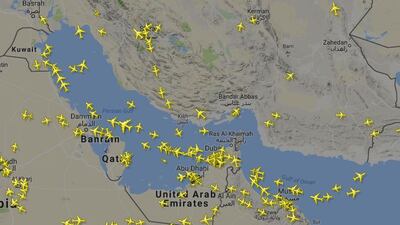Battling the congested roads of the UAE is one thing. But tackling the crowded skies of the country’s airspace is an even bigger challenge.
From December, though, flying through major airline hubs like Abu Dhabi and Dubai should become easier.
The end of the year will see the introduction of a new air traffic management system that uses the latest technology to safely manage the fast growing numbers of passenger jets passing through the region.
Described as: “one of the largest airspace changes the region has ever seen,” the UAE Airspace Restructuring Project (ARP) connects global navigation satellites directly to computerised on board aircraft systems.
It replaces traditional aircraft navigation systems, which are largely based on land beacons which guide aircraft along specific routes using way-points.
The new system is known as Performance Based Navigation, and is described by the General Civil Aviation Authority as "world's first airspace structure" to use this technology, which allows for much greater flexibility in flight plans, and maximises the use of existing air space.
Such is the complexity of the project that the GCAA calculates is has taken over 120,000 man hours, or the equivalent of nearly 15 years, to develop.
It has also required the retraining of 250 air-traffic controllers using simulators, and the co-operation of multiple aviation authorities and airlines, including the Sheikh Zayed Air Navigation Centre, Dubai Air Navigation Services, Abu Dhabi Airports Company and Abu Dhabi Department of Transport.
When the new system goes live on December 7, the results should be good for both passengers and the environment, The GCAA estimates that the fuel savings in the first year alone will be US$15 million, and equal to a reduction of 100,000 metric tonnes of carbon dioxide into the atmosphere.
Saif Al Suwaidi, the GCAA Director General, called the changes a: “historic moment in UAE aviation history,” adding: “The implementation of the UAE ARP has demonstrated our capability to safely meet the capacity requirements for the forecasted 2020 air traffic demand and beyond.”
Experts agree that improvements to air traffic control in the region are desperately needed.
_______________
Read more:
Congested airspace could cost Middle East $16 billion over next decade
Airspace management is key to Arabian Gulf economy
UK airspace at its 'limit' as holidaymakers enjoy their summer holidays
_______________
The Arabian Gulf is home some of the fastest expanding airlines in the world, including Emirates and Etihad, with both Dubai and Abu Dhabi expanding their airports to become major international transport hubs. Dubai International Airport is now the world’s busiest.
Together, Emirates and Etihad expect to be operating more than 500 aircraft between them by 2025, while flydubai expects to more than triple its fleet to 150, and Sharjah’s Air Arabia expand to 100 aircraft.
The problem has been made worse by conflicts in the region, including Iraq and Syria, which have reduced the safe air space which commercial airlines can use.
A 2014 report by the International Air Transport Association noted that between 40 to 60 per cent of air space in the region was reserved for military aircraft, with the organisation’s director general warning that: “Congestion is a real and rising problem.”
The air traffic management company Nats has calculated that the cost of congested airspace to the region could reach US$16 billion by 2026, if action is not taken.
Reducing the waiting time of aircraft by just one minute resulted in fuel savings of $2.5 million, when London’s Heathrow Airport improved its air traffic control in the 1990s, Nats says.
The GCAA predicts that the new changes will secure the UAE’s airspace network until 2040, allowing for the development of both Dubai World Central Al Maktoum International Airport and Abu Dhabi International Airport.


